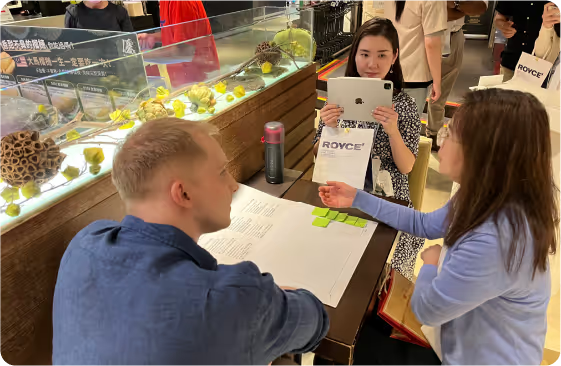
everyday shopping.


DESIGN DIRECTIVE 1



DESIGN DIRECTIVE 2



DESIGN DIRECTIVE 3



DESIGN DIRECTIVE 4


“I believe all the concepts are feasible, and we can allocate space in the store to showcase sustainability products and messaging.”
- Tony Liu, President, city'super

“Previously, I found it challenging to associate city'super with sustainability and ESG initiatives. However, this presentation has effectively convinced me otherwise.”
- Kate Chi, Marketing Manager, city'super
In the initial step of the design process, we gained a clear understanding of the project scope through a focus group session with city'super's stakeholders. The primary objective is to establish a collaborative and innovative supply chain with local farmers, emphasizing food safety, health, agri-food education, community supported agriculture, and the farm-to-table concept. The desired deliverables are concepts that differentiate city'super from competitors, enhance customer satisfaction, and align with their sustainability goals.
In the research process, we thoroughly investigated the production process, conducting interviews with industry experts to gain in-depth insights into how produce is shipped and distributed. Additionally, we extensively studied various businesses and brands to understand their unique value-added processes and delved into the certification process for organic produce.
Crucially, we focused on gathering customer feedback and understanding their sentiments towards produce and their overall shopping experience, through interviews and shop-alongs.


Our field research took us across Taiwan, examining each touch point involved in the journey of produce and good food. This included visits to farms, co-ops, distribution centers, supermarkets, testing facilities, and more. To ensure a comprehensive understanding of customer needs and desires, we conducted several rounds of qualitative research.
Furthermore, we conducted secondary research to explore how supermarkets and retailers, in general, view sustainability, examining actions taken by other retailers in this domain. After thoroughly analyzing all the research findings, we identified several promising opportunities to capitalize on.


In the process of redefining, we carefully synthesized all the research data, which led to the identification of six central opportunity areas for city'super. These areas aimed to transform city'super into a trusted source for healthy and fresh food recommendations, foster personal connections between shoppers and farmers, create value by linking premium imports with local products, shift the brand image to focus on premium products regardless of origin, improve communication of city'super's environmental initiatives, and help shoppers understand their sustainable shopping practices.
These opportunities were categorized into three high-level themes: creating trust, encouraging local engagement, and promoting awareness.

To ensure alignment and gather valuable insights, we sought feedback from city'super management. We conducted a preference activity that revealed their enthusiasm for the opportunities within the creating trust and encouraging local themes. Although they were excited about promoting awareness, concerns were raised about the necessary resources, staffing, and floorspace for those specific opportunities.
Following this, we engaged a group of shoppers in the same activity. The results showed broad interest in the opportunities across all three themes, particularly within the promoting awareness theme.
In our design process, our focus remains on serving the needs of the users within the given constraints, ensuring that the final solutions address the identified opportunities while aligning with city'super's objectives and resources.
In this step of the design process, we entered the prototyping phase by developing low-fidelity concept prototypes. These prototypes were designed to enhance awareness, build trust, and encourage shoppers to purchase locally produced foods. As essential design tools, low-fidelity prototypes play a crucial role in the iterative design process. By engaging shoppers with these prototypes, we gain valuable insights into their actual needs, interests, and goals, allowing us to better understand their interactions and preferences.
Throughout this phase, we iteratively refine the prototypes based on feedback and observations from shoppers. This process ensures that the final design solutions effectively address the identified opportunities while catering to the real-life needs of the shoppers.


Finally, we conducted extensive testing of the prototypes with shoppers at one of city'super's stores to gain valuable insights into their reactions and experiences. The feedback received from shoppers played a pivotal role in shaping our design decisions. Based on this feedback, we derived four design directives that will serve as guiding principles for our design work.
By thoroughly validating our prototypes with real users, we ensured that the final design solutions are tailored to meet the shoppers' preferences and needs. This iterative validation process allows us to refine and enhance the prototypes to create a more engaging and satisfying shopping experience at city'super, ensuring that the end results align with both the customers' expectations and city'super's objectives, ultimately contributing to the success of the project.

